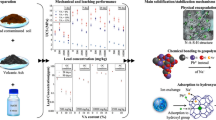Abstract
The paper discusses the addition of sodium hydroxide to readily available natural materials in Senegal, in order to produce stronger and more durable bricks. The case study involves the Tchieky clays which were mixed with varying amounts of NaOH and heated at temperatures of 40, 80 and 120°C for periods of up to 60 days. The caustic solution could be sodium hydroxide mixed with sodium silicate and water/seawater. In general the maximum strength was reached after 28 days for samples mixed with 8 M NaOH at 40°C. The bricks produced were shown to be durable and relatively inexpensive. The process does not generate pollutants and can use by-products, assisting with environmental problems.
Résumé
L’article présente comment l’addition d’hydroxyde de sodium à des matériaux naturels facilement disponibles au Sénégal permet de produire des briques plus résistantes et moins altérables. L’étude de cas concerne les argiles de Tchieky qui ont été mélangées avec des quantités variables de NaOH et chauffées à des températures de 40, 80 et 120°C pendant des durées allant jusqu’à 60 jours. La solution caustique pouvait être constituée d’hydroxyde de sodium mélangé à du silicate de sodium et de l’eau ou de l’eau de mer. En général la résistance maximum est atteinte après 28 jours pour des échantillons mélangés avec 8 M de NaOH à 40°C. Les briques produites se sont révélées résistantes et assez peu onéreuses à produire. Le procédé ne génère pas de polluant et peut utiliser des co-produits, en appui au traitement de questions environnementales.






Similar content being viewed by others
References
Bao Y, Grutzeck MW (2005) Solidification of sodium bearing waste using hydroceramic and portland cement binders. Ceram Trans 168:243–252 (Environmental Issues and Waste Management Technologies in the Ceramic and Nuclear Industries X)
Bao Y, Grutzeck MW (2006) General recipe and properties of a four inch hydroceramic waste form. In: Ceramic transactions, vol 176 (Environmental Issues and Waste Management Technologies in the Ceramic and Nuclear Industries XI). Am Ceram Soc, Westerville, OH, 2006, pp 63–74
Bao Y, Kwan S, Siemer DD, Grutzeck MW (2004) Binders for radioactive waste forms made from pretreated calcined sodium bearing waste (SBW). J Mater Sci 39(2):481–488
Bao Y, Grutzeck MW, Jantzen CM (2005) Preparation and properties of hydroceramic waste forms made with simulated Hanford low-activity waste. J Am Ceram Soc 88(12):3287–302
Berg LG, Remiznikova VI, Vlasov VV (1968) Nature of the interaction of kaolinite with some bases. Stekloobraznye Sistemy i Materialy 11(1):10–13
Breck DW (1974) Zeolite molecular sieves. John Wiley & Sons, New York
Diop MB, Grutzeck MW (2007) Low temperature process to create brick. Constr Build Mater. doi: 10.1015/j.conbuilmat.2007.03.004
Diop MB, Jauberthie R, Melinge Y, Estellé P, et Lanos C « Valorisation de tufs du Sénégal dans les mortiers: durabilité et mise en forme » XXIIIiéme Rencontres de Génie Civil 2005; Risques and Environnement
Dyer A (1988) An introduction to zeolite molecular sieves. John Wiley & Sons, New York
Grutzeck MW, Siemer DD (1997) Zeolites synthetized from Class F fly ash and sodium aluminate slurry. J Am Ceram Soc 80(9):2449–2453
Grutzeck MW, Kwan S, DiCola M (2004) Zeolite formation in alkali-activated cementitious systems. Cement Concrete Res 34(6):949–955
Palomo A, Blanco MT, Granizo ML, Puertas F, Vasquez T, Grutzeck MW (1999a) Chemical stability of cementious materials based on metakaolin. Cement Concrete Res 29(7):997–1004
Palomo A, Grutzeck MW, Blanco MT (1999b) Alkali-activated fly ashes: a cement for the future. Cement Concrete Res 29(8):1323–1329
Rahier H, Wullaert B, Van Mele B (2000) Influence of the degree of dehydroxylation of kaolinite on the properties of aluminosilicate glasses. J Therm Anal Calorim 62(2):417–427
Sazhin VS, Pankeeva NE (1967) Interaction of kaolinite with sodium hydroxide solutions. Ukrains’kii Khemichnii Zhurnal 33(5):528–530
Siemer DD, Grutzeck MW, Scheetz BE (2000) Comparison of materials for making hydroceramic waste forms. Ceram Trans 107:161–167 (Environmental Issues and Waste Management Technologies in the Ceramic and Nuclear Industries V)
Author information
Authors and Affiliations
Corresponding author
Rights and permissions
About this article
Cite this article
Diop, M.B., Grutzeck, M.W. Sodium silicate activated clay brick. Bull Eng Geol Environ 67, 499–505 (2008). https://doi.org/10.1007/s10064-008-0160-3
Received:
Accepted:
Published:
Issue Date:
DOI: https://doi.org/10.1007/s10064-008-0160-3




